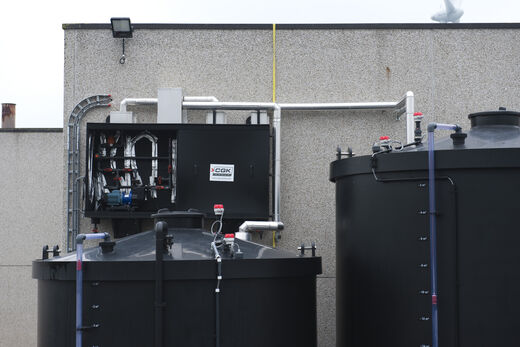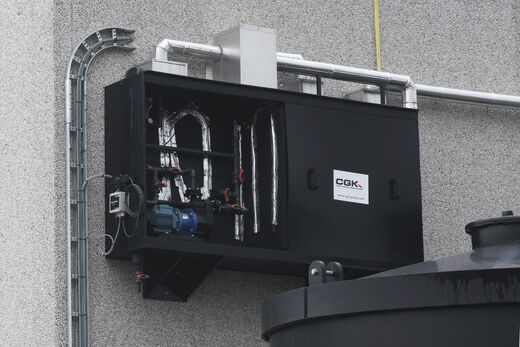Pump cabinets
A pump safely transports chemicals from tank to consumer. Electric pumps or pneumatic pumps: pump types are particularly diverse. The same applies to the material of the tank pipes: plastic, steel, stainless steel, ...
To use your pumps safely and conveniently, place them in a pump cabinet. It collects any losses in a drip tray with an emptying tap so they do not contaminate the environment. You can perfectly see what is happening thanks to the transparent, lockable door in a colour of your choice. The tank is thus filled via the pump cabinet and the system does not come under harmful pressure. The system also guarantees a constant supply for your scrubber.
Advantages of a pump cabinet
The pump cabinets are chemically resistant, structurally sound, weatherproof and UV-resistant. They literally stand on their own, both indoors and outdoors, and they can handle any piping thanks to the modular PE sheet.
CGK Group installs the necessary accessories on your pump cabinet to start up the whole installation: a suction cylinder, a pouring funnel, an automatic siphon vessel, ... The assembly is done, if you wish, in our workshops, which is smoother and allows a pressure test. For example, do you want a standard pump cabinet with PPE hatch or a more discreet custom-made one, with fully automatic dosing system? It's all possible.
Suction pumps do not normally require a separate pump cabinet, yet the advantages speak for themselves:
- Plastic cabinet with transparent front panel: the user sees what is happening.
- Includes drain valve: any leaks and their projections remain in the cabinet. Your employees are not at any risk..
- Assembly can be done in a workshop or on site. An additional pressure test remains possible.
Request the price for your pump cabinet(s)
Do you already have an idea of exactly what you need? Fill out the form below and we'll get you an estimate.

Tips & regulations
Provide an overflow valve
When the pump is working but the valves in the discharge line are closed or there is a greater back pressure, the pump may heat up. Thus, the pipe, or even the pump, can break. The solution here is an overflow valve.
Place the valve after the pump. Set it to a predetermined pressure, say 3 bar. If the line pressure exceeds that 3 bar, the overflow valve opens and evacuates the liquid to the tank. This way, the liquid cannot heat up. This way of doing things is a little more complex and expensive, because it requires more piping.
A simpler way is evacuation to a pump connection, but then the disadvantage is that if the pump runs for a long time, the fluid heats up and the probability of failure increases.
Avoid dry running
Never let your tank run dry. This happens when the tank is empty but the pump keeps running. The pump parts heat up and the unit breaks down. Therefore, provide a contact on the float so the pump runs out of power if the float gets too low.
Install flush valves
Be sure to install flush valves in the pump cabinet. This will flush the pipe and pump before any repairs or replacements need to be made. This will allow you to work on the system safely.








